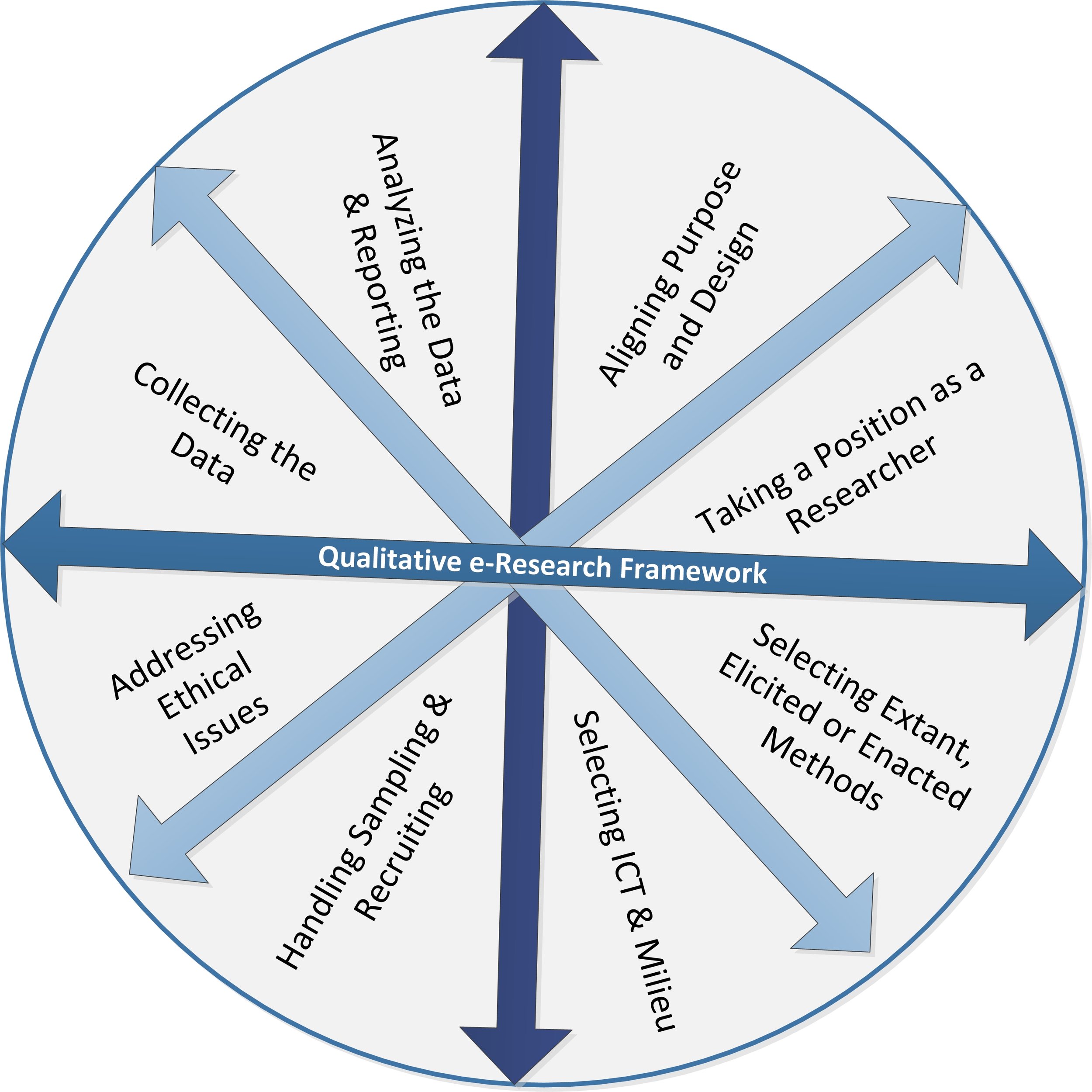How to study #hashtags
By Janet Salmons, PhD, author of Doing Qualitative Research Online (2022).
Hashtags allow Internet users to find people of like mind and specific content.
Finding what we are looking for online can be challenging to say the least! Every page we open offers distractions that can pull us off task. Where are the experts in my field of study, where are the conversations about the topic of interest? Within social networking sites what used to be called “the number sign” or the “pound sign,” now known as the hashtag # symbol, serves a useful purpose in this regard. Writers and creators insert the # to signal readers that they can find more on a specific concept, name, or topic. This functionality serves “to organize knowledge and facilitate access and enable retrieval of information” (Giannoulakis & Tsapatsoulis, 2016). Readers can sort through posts and comments to find other sources indicated by the presence of a hashtag.
Zappavigna (2012) observed:
This cultural shift to interpersonal search has resulted in the emergence of searchable talk, that is, online discourse where the primary function appears to be affiliation via ‘findability’. This kind of talk expands linguistic meaning potential by using punctuation to incorporate metadata into language so that online talk can be found.
Clearly hashtags are used for more than simple keyword searches. Giannoulakis & Tsapatsoulis (2016) point out that
users extend the function of hashtagging beyond findability and give hashtags a metacommunicative use. According to Daer et al. (2014) the metacommunicative function can be split into four codes: ‘emphasizing’, ‘iterating’, ‘critiquing’, ‘identifying’, and ‘rallying’. ‘Emphasizing’ is used to give emphasis or call attention; ‘critiquing’ expresses judgment or verdict; ‘identifying’ is used to refer to the author of the post; ‘iterating’ to expresses humor and ‘rallying’ brings awareness or support to a cause.
Hashtags offer online researchers ways to identify popular topics, trace viral messages, and locate influential thought leaders. Learn more about how researchers use hashtags with this multidisciplinary collection of open access articles.
References
Giannoulakis, S., & Tsapatsoulis, N. (2016). Evaluating the descriptive power of Instagram hashtags. Journal of Innovation in Digital Ecosystems, 3(2), 114-129. https://doi.org/https://doi.org/10.1016/j.jides.2016.10.001
Zappavigna, M. (2012). Ambient affiliation: a linguistic perspective on twitter. In SAGE Internet Research Methods (pp. v4-193-v4-214). SAGE Publications Ltd, https://doi.org/10.4135/9781446268513
How do researchers use qualitative and quantitative methods to study and trace hashtags?
Bogen, K. W., Bhuptani, P. H., Haikalis, M., & Orchowski, L. M. (2022). A Qualitative Analysis of How Individuals Utilized the Twitter Hashtags #NotOkay and #MeToo to Comment on the Perpetration of Interpersonal Violence. Social Media + Society, 8(1). https://doi.org/10.1177/20563051221086229
Abstract. The present study examined how individuals describe the nature of interpersonal violence perpetrated against them using the Twitter hashtags #NotOkay and #MeToo. Iterative qualitative coding of 437 tweets resulted in four major themes (i.e., the nature of violence and tactics utilized, the identity of the perpetrator, the location of the assault, and whether the perpetrator was held accountable). Subthemes nested beneath perpetrator identity included whether the perpetrator was known, as well as perpetrator gender identity. Subthemes nested beneath perpetrator tactic included the presence of multiple perpetrators, whether the assault was a crime of opportunity, engagement in physical aggression, utilization of psychological abuse, perpetration of sexual abuse, substance use at the time of the assault (victim and/or perpetrator), whether the abuse persisted, and whether the perpetrator used a weapon. Findings contradict stereotypes that frame interpersonal violence as a single occurrence committed by a stranger who planned an attack using a weapon.
Caldeira, S. P. (2023). The Pluralization of Feminist Hashtag Landscapes: An Exploratory Mapping of Feminist Hashtags on Portuguese Instagram. Social Media + Society, 9(2). https://doi.org/10.1177/20563051231171638
Abstract. Feminist hashtags are often studied in the context of concise and highly visible hashtag movements. However, most social media and hashtag use exist outside the narrow confines of such movements. This article broadens the scope of exploration of hashtag feminisms, encompassing not only well-defined hashtag movements but also generic hashtags where feminist action might not be overtly or strategically mobilized. It grounds these explorations on the mapping of the Portuguese landscape of feminist hashtags on Instagram. Starting from four hashtags—#feminismoportugal, #igualdadedegénero, #naopartilhes, and #portugalmaisigual—this study explores hashtagging practices in 294 posts created by 101 users. Combining the analysis of a hashtag co-occurrences network with qualitative close readings, this article explores how these online practices incorporate varied typologies of fourth-wave feminist action, how a focus on intersectionality can be conducive to a heterogeneous and differentiated hashtag landscape, and how questions of effectiveness of hashtag activism can be problematized by low metrics of engagement. As such, this exploration of the Portuguese feminist hashtag landscape serves as an entry point for a critical reflection on the everyday uses of feminist hashtags, illustrating the tensions, complexities, and contradictions that such pluralized hashtag landscapes can encompass.
Geboers, M. A., & Van De Wiele, C. T. (2020). Machine Vision and Social Media Images: Why Hashtags Matter. Social Media + Society, 6(2). https://doi.org/10.1177/2056305120928485
Abstract. Studying images in social media poses specific methodological challenges, which in turn have directed scholarly attention toward the computational interpretation of visual data. When analyzing large numbers of images, both traditional content analysis as well as cultural analytics have proven valuable. However, these techniques do not take into account the contextualization of images within a socio-technical environment. As the meaning of social media images is co-created by online publics, bound through networked practices, these visuals should be analyzed on the level of their networked contextualization. Although machine vision is increasingly adept at recognizing faces and features, its performance in grasping the meaning of social media images remains limited. Combining automated analyses of images with platform data opens up the possibility to study images in the context of their resonance within and across online discursive spaces. This article explores the capacities of hashtags and retweet counts to complement the automated assessment of social media images, doing justice to both the visual elements of an image and the contextual elements encoded through the hashtag practices of networked publics.
Omena, J. J., Rabello, E. T., & Mintz, A. G. (2020). Digital Methods for Hashtag Engagement Research. Social Media + Society, 6(3). https://doi.org/10.1177/2056305120940697
Abstract. This article seeks to contribute to the field of digital research by critically accounting for the relationship between hashtags and their forms of grammatization—the platform techno-materialization process of online activity. We approach hashtags as sociotechnical formations that serve social media research not only as criteria in corpus selection but also displaying the complexity of the online engagement and its entanglement with the technicity of web platforms. Therefore, the study of hashtag engagement requires a grasping of the functioning of the platform itself (technicity) along with the platform grammatization. In this respect, we propose the three-layered (3L) perspective for addressing hashtag engagement. The first contemplates potential differences between high-visibility and ordinary hashtag usage culture, its related actors, and content. The second focuses on hashtagging activity and the repurposing of how hashtags can be differently embedded into social media databases. The last layer looks particularly into the images and texts to which hashtags are brought to relation. To operationalize the 3L framework, we draw on the case of the “impeachment-cum-coup” of Brazilian president Dilma Rousseff. When cross-read, the three layers add value to one another, providing also difference visions of the high-visibility and ordinary groups.
Pilař, L., Kvasničková Stanislavská, L., Kvasnička, R., Bouda, P., & Pitrová, J. (2021). Framework for Social Media Analysis Based on Hashtag Research. Applied Sciences, 11(8), 3697. https://www.mdpi.com/2076-3417/11/8/3697
Abstract. Social networks have become a common part of many people’s daily lives. Users spend more and more time on these platforms and create an active and passive digital footprint through their interaction with other subjects. These data have high research potential in many fields, because understanding people’s communication on social media is essential to understanding their attitudes, experiences and behaviours. Social media analysis is a relatively new subject. There is still a need to develop methods and tools for researchers to help solve typical problems associated with this area. A researcher will be able to focus on the subject of research entirely. This article describes the Social Media Analysis based on Hashtag Research (SMAHR) framework, which uses social network analysis methods to explore social media communication through a network of hashtags. The results show that social media analysis based on hashtags provides information applicable to theoretical research and practical strategic marketing and management applications.
Rathnayake, C., & Ntalla, I. (2020). “Visual Affluence” in Social Photography: Applicability of Image Segmentation as a Visually Oriented Approach to Study Instagram Hashtags. Social Media + Society, 6(2). https://doi.org/10.1177/2056305120924758
Abstract. The aim of the study is to examine the applicability of image segmentation—identification of objects/regions by partitioning images—to examine online social photography. We argue that the need for a meaning-independent reading of online social photography within social markers, such as hashtags, arises due to two characteristics of social photography: (1) internal incongruence resulting from user-driven construction and (2) variability of content in terms of visual attributes, such as color combinations, brightness, and details in backgrounds. We suggest visual affluence—plenitude of visual stimuli, such as objects and surfaces containing a variety of color regions, present in visual imagery—as a basis for classifying visual content and image segmentation as a technique to measure affluence. We demonstrate that images containing objects with complex texture and background patterns are more affluent, while images that include blurry backgrounds are less affluent than others. Moreover, images that contain letters and dark, single-color backgrounds are less affluent than images that include subtle shades. Mann–Whitney U test results for ten pairs of hashtags showed that eight pairs had significant differences in visual affluence. The proposed measure can be used to encourage a “visually oriented” turn in online social photography research that can benefit from hybrid methods that are able to extrapolate micro-level findings to macro-level effects.
Rathnayake, C., & Suthers, D. D. (2023). A template for mapping emotion expression within hashtag publics. Communication and the Public, 8(3), 135-155. https://doi.org/10.1177/20570473231169787
Abstract. Current literature on networked publics lacks research that examines how emotions are mobilised around specific actors, and quantitative analysis of affective phenomena is limited to vanity metrics. We address this issue by developing a network analytic routine, which guides the attribution of emotions contained in hashtagged tweets to their sources and targets. The proposed template enables identification of networked inconsequentiality (i.e., inability to trigger dialogue), reply targets (i.e., individuals targeted in replies) and voice agents (i.e., senders of replicated utterances). We demonstrate this approach with two data sets based on the hashtags #Newzealand (n = 131,523) and #SriLanka (n = 145,868) covering two major incidents of terrorism related to opposing extremist ideologies. In addition to the methodological contribution, the study demonstrates that user-driven emergence of networked leadership takes place based on conventional structures of power in which individuals with high power and social status are likely to emerge as targets as well as sources of emotions.
Rathnayake, C., & Suthers, D. (2023). Towards a ‘pluralist’ approach for examining structures of interwoven multimodal discourse on social media. New Media & Society, 0(0). https://doi.org/10.1177/14614448231189800
Abstract. This study proposes a framework for examining hashtagged content on social media, which captures how specific issue frames (i.e. hashtags) contribute to navigable structures. We introduce ‘interwoven multimodal discourse’ as a pluralist alternative to the widely applied unitary approach in which trending hashtags serve as primary sites of analysis. The study argues that ‘interweaving’ of social media discourse takes place through practices such as hashtag colocation, which result in ambient and navigable structures. Analysis of hashtag colocation networks can serve as an approach for mapping ambient affiliations accessible through such structures. We analyse a hashtag colocation network constructed using a sample of 1100 Instagram posts related to climate change uploaded during the United Nations Climate Change Conference 2021 (COP26) held in Glasgow to demonstrate two structural properties of interwoven discourse on Instagram: (1) hashtags contribute to multiple thematic clusters and (2) micro-level hashtags representing secondary topics are nested within larger thematic clusters.
Abstract. Over the past few years, online hashtags have gained tremendous fame mainly because of two reasons: first, as digital information trackers and second, as short and spontaneous communication tags. The present study aims to explore language factors in three types of Facebook hashtags, that is, long, short, and multiple mixed. It further investigates each factor’s role in online communication by performing an in-depth examination through activities and close-ended questions. First, it identifies factors through the writing activities where participants wrote different hashtags with their intention behind each hashtag. It follows interpretation activities in which other participants wrote their interpretations about the already written hashtags. Further, a 5-point Likert scale questionnaire was developed to note participants’ opinions about hashtags which were evaluated by the SPSS factor analysis test. Results of the study are divided into three sections and showed that lack of adequate vocabulary and lower casing is an important factor affecting digital communication in Pakistan. It is also suggested that teachers should play their part to improve informal writing and digital literacy in Pakistan.































Do you think about research questions as an insider, outsider, or somewhere in between? Why is positionality important in online research?